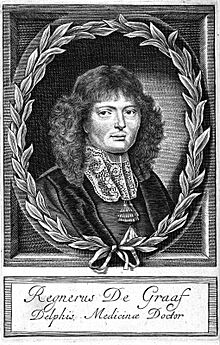Regnier de Graaf facts for kids
Quick facts for kids
Regnier de Graaf
|
|
|---|---|

Portrait photo
|
|
| Born | 30 July 1641 Schoonhoven, Dutch Republic
|
| Died | 17 August 1673 (aged 32) Delft, Netherlands
|
| Nationality | Dutch |
| Known for | reproductive biology syringe ovarian follicle |
| Scientific career | |
| Fields | anatomist |
Regnier de Graaf (English spelling), original Dutch spelling Reinier de Graaf, or Latinized Reijnerus de Graeff (30 July 1641 – 17 August 1673), was a Dutch physician, physiologist and anatomist who made key discoveries in reproductive biology. He specialized in iatrochemistry and iatrogenesis.
De Graaf was born in Schoonhoven in a Roman Catholic family, as the son of a carpenter/engineer or architect. He studied medicine in Leuven (1658), Utrecht and Leiden (1663). There his co-students were Jan Swammerdam, Niels Stensen, Ole Borch and Frederik Ruysch, cooperating with professor Franciscus Sylvius, Johannes van Horne and Lucas Schacht. All of them were interested in the organs of procreation and influenced by Rene Descartes' iatrophysical approach. He submitted his doctoral thesis on the pancreas, and in 1665 he went (together with his brother) to France where he further experimented on dogs, cooperating with Pierre Bourdelot. He obtained his medical degree from the University of Angers with Jean Chapelain as his translator. Back in the Dutch Republic, De Graaf established himself at Oude Delft.
In May 1672 he married Maria van Dijk. As a correspondent of the Royal Society in London, De Graaf recommended (at the end of April) Henry Oldenburg that attention should be paid to autodidact Antonie van Leeuwenhoek and his work on the improvement of the microscope. De Graaf died on 17 August and was buried respectfully on 21 August in the nearby Old Church, Delft on a prominent spot, at the choir.
Gallery
See also
 In Spanish: Regnier de Graaf para niños
In Spanish: Regnier de Graaf para niños



